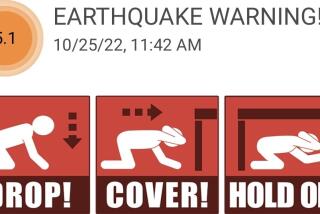Preparedness Program on the Rise After Quake : Santa Clarita: Participation in SECURE program has skyrocketed with 5,500 new members since Jan. 17 temblor.
SANTA CLARITA â It took organizers here two years to convince 3,000 people that they need to know what to do in a disaster. It took Mother Nature less than a minute to persuade nearly twice as many.
Participation in the cityâs disaster preparedness program, Santa Clarita Educated Communities United in Response to Emergencies, has skyrocketed since the Northridge earthquake--adding 5,550 members since last Jan. 17.
Launched three years ago, SECURE teaches residents how to be self-sufficient for 72 hours after a major disaster.
Among other things, participants learn how to prepare a survival kit, to shut off the gas in a house and to draft a plan that gives family members specific duties if a disaster occurs. Some volunteers in turn become trainers, making presentations to neighborhood groups, businesses, schools and service clubs to prepare them for disasters.
Prior to the earthquake, about 3,500 people had participated in the program during its two-year tenure. SECURE has since trained an additional 5,500 residents, most of whom signed up during the three months that followed the quake.
âItâs our best marketing tool weâve ever developed,â quipped Priscilla Nielsen, city volunteer coordinator.
Several SECURE participants said they relied on their training after the earthquake struck.
âThe best thing we learned was that everybody was there for each other,â said Cathy Bauer, a Valencia resident.
Bauer, 37, was especially glad she had posted a SECURE list on her refrigerator that told her what to do after the quake struck.
âIt was a lifesaver for me,â said Bauer. âI looked at it and it helped me focus. It was very methodical.â
Other program participants agreed.
âWhen they (SECURE instructors) came, they talked about how to prepare yourself before, during and after (a disaster),â said Jamie Choate, a Saugus resident.
One tip was having large containers of water stored at home.
âIt was the SECURE program who turned us on to these 30-gallon juice containers. So everyone here had at least 30 gallons of water,â Choate said.
*
Choate, 48, said her neighbors mobilized quickly after the Northridge quake, checking on one another. The group quickly organized and began offering first aid to other neighborhoods. It even had breakfast cooking by the time light appeared in the Jan. 17 morning sky.
âWe had discussed these things over and over and over,â said Choate. âEverybody had (assigned) jobs.â
Choate said the program could be even more effective if annual refresher courses were offered to neighborhoods.
Prior to the temblor, community interest in SECURE had dwindled from when it was first introduced, according to Adele Macpherson, city emergency preparedness coordinator.
But fueled by new interest, SECURE organizers are now developing a simpler version of the program to be offered to senior citizens, including those who are housebound and likely to be isolated during a major disaster.
âThe program we teach is still basic preparedness,â said Macpherson. âThe earthquake did make us realize the seniors were a population that didnât have the information.â
A month before the Northridge quake struck, the Emergency Preparedness Commission for Los Angeles County and its cities recognized Santa Clarita for SECUREâs use of volunteers and private companies to offer disaster training free to the public.
More to Read
Sign up for Essential California
The most important California stories and recommendations in your inbox every morning.
You may occasionally receive promotional content from the Los Angeles Times.










